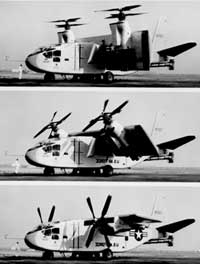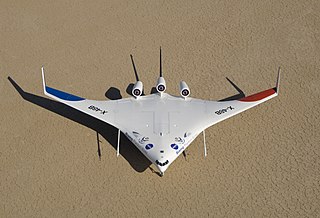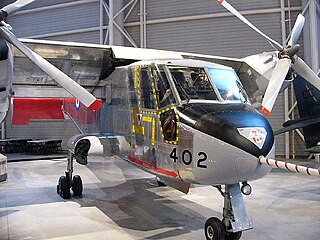
A vertical take-off and landing (VTOL) aircraft is one that can take off and land vertically without relying on a runway. This classification can include a variety of types of aircraft including helicopters as well as thrust-vectoring fixed-wing aircraft and other hybrid aircraft with powered rotors such as cyclogyros/cyclocopters and gyrodynes.

A tiltrotor is an aircraft that generates lift and propulsion by way of one or more powered rotors mounted on rotating shafts or nacelles usually at the ends of a fixed wing. Almost all tiltrotors use a transverse rotor design, with a few exceptions that use other multirotor layouts.

A tiltwing aircraft features a wing that is horizontal for conventional forward flight and rotates up for vertical takeoff and landing. It is similar to the tiltrotor design where only the propeller and engine rotate. Tiltwing aircraft are typically fully capable of VTOL operations.

The Boeing X-48 is an American experimental unmanned aerial vehicle (UAV) built to investigate the characteristics of blended wing body (BWB) aircraft. Boeing designed the X-48 and two examples were built by Cranfield Aerospace in the UK. Boeing began flight testing the X-48B version for NASA in 2007. The X-48B was later modified into the X-48C version, which was flight tested from August 2012 to April 2013. Boeing and NASA plan to develop a larger BWB demonstrator.

AeroVironment, Inc. is an American defense contractor headquartered in Arlington, Virginia, that designs and manufactures unmanned aerial vehicles (UAVs). Paul B. MacCready Jr., a designer of human-powered aircraft, founded the company in 1971. The company is best known for its lightweight human-powered and solar-powered vehicles. The company is the US military's top supplier of small drones —notably the Raven, Switchblade, Wasp and Puma models.

The Canadair CL-84 "Dynavert", designated by the Canadian Forces as the CX-131, was a V/STOL turbine tiltwing monoplane designed and manufactured by Canadair between 1964 and 1972. Only four of these experimental aircraft were built with three entering flight testing. Two of the CL-84s crashed due to mechanical failures, with no fatalities occurring in either of the accidents. Despite the CL-84 being successful in the experimental and operational trials carried out between 1972 and 1974, none of the prospective customers placed any orders for the type.

A rotorcraft or rotary-wing aircraft is a heavier-than-air aircraft with rotary wings or rotor blades, which generate lift by rotating around a vertical mast. Several rotor blades mounted on a single mast are referred to as a rotor. The International Civil Aviation Organization (ICAO) defines a rotorcraft as "supported in flight by the reactions of the air on one or more rotors".

An electric aircraft is an aircraft powered by electricity. Electric aircraft are seen as a way to reduce the environmental effects of aviation, providing zero emissions and quieter flights. Electricity may be supplied by a variety of methods, the most common being batteries. Most have electric motors driving propellers or turbines.

The Doak VZ-4 was an American prototype Vertical Takeoff and Landing (VTOL) aircraft built in the 1950s for service in the United States Army. Only a single prototype was built, and the U.S. Army withdrew it from active trials in 1963.
Deflected slipstream is an approach to creating an aircraft that can take off and land vertically (VTOL), or at least with a very short runway (STOL). The basic principle is to deflect the slipstream from one or more propellers approximately 90 degrees, to create an upward thrust for vertical takeoff and a downward air cushion for landing. Once airborne, the flaps are retracted so the airplane can fly horizontally.

Aurora Flight Sciences (AFS) is an American aviation and aeronautics research subsidiary of Boeing that specializes in special-purpose unmanned aerial vehicles. Aurora's headquarters is at Manassas Regional Airport.

The Vertical Take-Off and Landing Experimental Aircraft program was an American research project sponsored by the Defense Advanced Research Projects Agency (DARPA). The goal of the program was to demonstrate a VTOL aircraft design that can take off vertically and efficiently hover, while flying faster than conventional rotorcraft. There have been many previous attempts, most of them unsuccessful as of 2015.

Lift fan is an aircraft configuration in which lifting fans are located in large holes in an otherwise conventional fixed wing or fuselage. It is used for V/STOL operation.

The NASA X-57 Maxwell was an experimental aircraft developed by NASA, intended to demonstrate technology to reduce fuel use, emissions, and noise. The first flight of the X-57 was scheduled to take place in 2023, but the program was cancelled due to problems with the propulsion system.
The Aeronautics Research Mission Directorate (ARMD) is one of five mission directorates within NASA, the other four being the Exploration Systems Development Mission Directorate, the Space Operations Mission Directorate, the Science Mission Directorate, and the Space Technology Mission Directorate. The ARMD is responsible for NASA's aeronautical research, which benefits the commercial, military, and general aviation sectors. The current NASA associate administrator heading ARMD is Robert A. Pearce who has held the position since 2019.
Urban Air Mobility (UAM) is the use of small, highly automated aircraft to carry passengers or cargo at lower altitudes in urban and suburban areas which have been developed in response to traffic congestion. It usually refers to existing and emerging technologies such as traditional helicopters, vertical-takeoff-and-landing aircraft (VTOL), electrically propelled vertical-takeoff-and-landing aircraft (eVTOL), and unmanned aerial vehicles (UAVs). These aircraft are characterized by the use of multiple electric-powered rotors or fans for lift and propulsion, along with fly-by-wire systems to control them. Inventors have explored urban air mobility concepts since the early days of powered flight. However, advances in materials, computerized flight controls, batteries and electric motors improved innovation and designs beginning in the late 2010s. Most UAM proponents envision that the aircraft will be owned and operated by professional operators, as with taxis, rather than by private individuals.
The Airbus CityAirbus is a multinational project by Airbus Helicopters to produce an electrically powered VTOL personal air vehicle demonstrator. It is intended for the air taxi role, to avoid ground traffic congestion.

The XTI TriFan 600 is a vertical takeoff and landing aircraft currently under development by XTI Aircraft Company. The TriFan 600 is referred to as a Vertical Lift Crossover Airplane (VLCA) by XTI to differentiate its range and speed from the many short-range, low-speed electric VTOL (eVTOL) aircraft under development.
An electric vertical take-off and landing (eVTOL) aircraft is a variety of VTOL aircraft that uses electric power to hover, take off, and land vertically. This technology came about thanks to major advances in electric propulsion and the emerging need for new aerial vehicles for urban air mobility that can enable greener and quieter flights. Electric and hybrid propulsion systems (EHPS) have also the potential of lowering the operating costs of aircraft.














